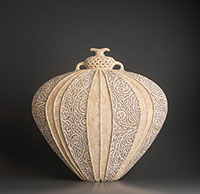
Working from her studio in the hills behind the small northern NSW town of Mullumbimby, Avital Sheffer creates profoundly beautiful vessels that have attracted international recognition. An exhibition of Sheffer’s hand-built ceramic art resonates the atmosphere of a sacred space. The forms may be thought of as portals between realms past and future, temporal and spiritual. Sheffer tells that the title for her current body of work ‘refers to the capacity of vessels to tell stories, to store knowledge, to keep records of place and time. There is inherent poetry in such intimate, yet collective memory. I perceive material and spirit as inseparable.’
Sheffer’s practice articulates a long, historic continuum. In the tradition of ancient ceramics, she builds her ware with coils of clay. From a predetermined base each vessel develops gradually and intuitively to assume its idiosyncratic character. When the form has been resolved, attention is focused on the surface of the raw clay. Textural enhancement is created with decorative incisions and appliquéd pieces. ‘I’m curious about the way the light will fall on the work,’ Sheffer imparts. ‘All the while I am searching for lines that complement or challenge the form.’ Engobes and dry glazes are subsequently applied. Following several firings, the surface is clad with calligraphic imagery and ancient text extracts that have been chosen for visual integration rather than any instructive purpose. The vessel is once again fired, permanently embedding the silkscreened artwork into its skin.
In shape and decorative features, Sheffer’s Frasco vessels personify the olden Spanish word ‘frasco’ that denotes a narrow-necked pouring receptacle. ‘With these pieces I wanted to create a series of volumes and lines to evoke a sense of flowing -stillness and motion,’ she explains. The rotund forms contain inert potentiality which can be poured forth through the tiny aperture in the curvilinear apex. Conversely, the arching necks may be thought of as reaching out to drink in etheric nourishment for future sharing. The elegant sweep of the vessels’ handles reiterates the symbolism.A somewhat similar notion of sharing invests the Agora VI work. In Ancient Greece the agora was an open-air place of encounter and philosophical exchanges. The vessel’s voluminous form contains much to be communicated. Very small handles offer no distraction. A feathery, central ochre design leads from the base’s cleft up to an organic-looking orifice. Amplifying contour, the vessel is swathed in crossed, undulating bands. Sheffer likens them to ‘the drape of an off-the-shoulder shawl that both covers and reveals.’
The Neuma vessels take their title and inspiration from the Greek word ‘pneuma’, signifying ‘air’ or ‘that which can be breathed’. Intended to evince a living presence, Nuema I has a rising swell of form that resembles the diaphragm’s intaking of air. Vertical 3D segments rhythmically expand and contract in a semblance of breathing. The small branching fixture at the vessel’s top also directs attention up, out, in, down. Below it, the oval sphere is perforated – the holes granting access to an enclosed mystery.Other Neuma ceramics assume a very different appearance. The word ‘pneuma’ can also translate as the ‘vital spirit’ or ‘creative force’. In Neuma V, three spherical volumes rise in decreasing size towards an elongated, narrow neck. Culminating in an oblique, almost beak-like shape, it is as if the vessel is stretching to receive creative sustenance. A trio of small handles extending directly from the lip lead the gaze again to the body. Clothing it, the wealth of decorative features is indicative of what kindles within.
The porous tactility of Sheffer’s ceramic art epitomises the primal nature of clay, fire, water and time. ‘An awareness of the earth as a great repository – an archive for the human endeavour, is part of my internal landscape,’ she conveys. Her eloquent vessels are not made for functional purpose but rather, to initiate a contemplative response. They convey a visual cadence akin to that of verse, and as such, we experience a poetic connection that belies their solid presence.
Receive e-mail updates on our exhibitions, events and more
Subscribe Now